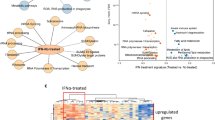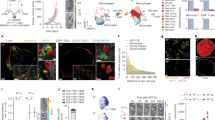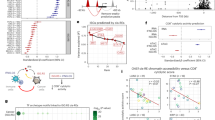Abstract
Interferon alpha (IFN-α) represents an adjuvant therapy of proven effectiveness in increasing disease-free interval and survival in subgroups of melanoma patients. Since high doses of cytokine are required, the treatment is often accompanied by toxic side effects. Furthermore, naturally occurring insensitivity to IFN-α may hamper its therapeutic efficacy. Clinical, molecular or immunological markers enabling the selection of potential responders have not been identified so far. To explore the molecular basis of IFN-α responsiveness, we analysed the expression pattern of about 7000 genes in IFN-α sensitive and resistant cell lines and we compared the transcription profiles of cells cultured in the presence or absence of the cytokine using high-density oligonucleotide arrays. Melanoma cell lines were screened for their sensitivity to proliferation inhibition and HLA class I induction upon IFN-α treatment by standard 3H-thymidine incorporation and flow-cytometry. The study of 4 sensitive and 2 resistant cell lines allowed the identification of 4 genes (RCC1, IFI16, hox2 and h19) preferentially transcribed in sensitive cells and 2 (SHB and PKC-ζ) preferentially expressed in resistant cells. IFN-α stimulation resulted in the expression of a panel of 19 known inducible genes in sensitive but not in resistant cells. Moreover a group of 30 novel IFN-α inducible genes was identified. These data may provide a useful basis to develop diagnostic tools to select potential IFN-α responders eligible for treatment, while avoiding unnecessary toxicity to non-responders. Furthermore, by extending the knowledge of the polymorphic effects of IFN-α on gene expression, they offer novel clues to the study of its pleiotropic toxicity. © 2001 Cancer Research Campaign http://www.bjcancer.com
Similar content being viewed by others
Article PDF
Change history
16 November 2011
This paper was modified 12 months after initial publication to switch to Creative Commons licence terms, as noted at publication
References
Acampora D, D’Esposito M, Faiella A, Pannese M, Migliaccio E, Morelli F, Stornaiuolo A, Nigro V, Simeone A and Boncinelli E (1989) The human HOX gene family. Nucleic Acids Res 17: 10385–10402
Adams F, Fernandez F and Mavligit G (1988) Interferon-induced organic mental disorders associated with unsuspected pre-existing neurologic abnormalities. J Neurooncol 6: 355–359
Aebi M, Faeh J, Hurt N, Samuel CE, Thomis DC, Bazzogher L, Pavlovic J, Haller O and Staheli P (1989) cDNA structures and regulation of two interferon-induced human Mx proteins. Mol Cell Biol 9: 5062–5072
Agarwala SS and Kirkwood JM (1996) Interferons in melanoma. Curr Opin Oncol 8: 167–174
Barbee JL, Loomis CR, Deutscher SL and Burns DJ (1993) The cDNA sequence encoding human protein kinase C-zeta. Gene 132: 305–306
Bischoff FR and Ponstingl H (1991) Catalysis of guanine nucleotide exchange on Ran by the mitotic regulator RCC1. Nature 354: 80–82
Brannan CI, Dees EC, Ingram RS and Tilghman SM (1990) The product of the H19 gene may function as an RNA. Mol Cell Biol 19: 28–36
Crackower MA, Scherer SW, Rommens JM, Hui CC, Poorkaj P, Soder S, Cobben JM, Hudgins L, Evans JP and Tsui LC (1996) Characterization of the split hand/split foot malformationlocus SHFM1 at 7q21.3–q22.1 and analysis of a candidate gene for its expression during limb development. Hum Mol Gen 5: 571–579
Deblandre GA, Marinx OP, Evans SS, Majaj S, Leo O, Caput D, Huez GA and Wathelet MG (1995) Expression cloning of an interferon-inducible 17-kDa membrane protein implicate in the control of cell growth. J Biol Chem 270: 23860–23866
De La Salmonière P, Grob J-J, Dreno B, Delaunay M and Chastang C (2000) White blood cell count: a prognostic factor and possible subset indicator of optimal treatment with low dose adjuvant interferon in primary melanoma. Clin Cancer Res 6: 4713–4718
Der SD, Zhou A, Williams BR and Silverman RH (1998) Identification of genes differentially regulated by interferon alpha, beta, or gamma using oligonucleotide arrays. Proc Natl Acad Sci USA 95: 15623–15628
Fambrough D, McClure K, Kazlauskas A and Lander ES (1999) Diverse signaling pathways activated by growth factor receptors induce broadly overlapping, rather than independent, sets of genes. Cell 97: 727–741
Grob JJ, Dreno B, de la Salmonière P, Delaunay M, Cupissol D, Guillot B, Souteyrand P, Sassolas B, Cesarini J-P, Lionnet S, Lok C, Chastang C and Bonerandi JJ (1998) Randomised trial of interferon α-2a as adjuvant therapy in resected primary melanoma thicker than 1.5 mm without clinically detectable node metastases. Lancet 351: 1905–1910
Gurney ME, Heinrich SP, Lee MR and Yin HS (1986) Molecular cloning and expression of neuroleukin, a neurotrophic factor for spinal and sensory neurons. Science 234: 566–574
Itoh S, Harada H, Fujita T, Mimura T and Taniguchi T (1989) Sequence of a cDNA coding for human IRF-2. Nucleic Acids Res 17: 8372–8372
Iyer VR, Eisen MB, Ross DT, Schuler G, Moore T, Lee JCF, Trent JM, Staudt LM, Hudson J, Boguski MS, Lashkari D, Shalon D, Botstein D and Brown PO (1999) The transcriptional program in the response of human fibroblasts to serum. Science 283: 83–87
Keilholz U and Eggermont AMM (2000) The emerging role of cytokines in the treatment of advanced melanoma. Oncology 58: 89–95
Kirkwood JM (1998) Adjuvant IFN alpha2 therapy of melanoma. Lancet 351: 1901–1903
Lipshutz RJ, Fodor SPA, Gingeras TR and Lockhart DJ (1999) High density synthetic oligonucleotide arrays. Nature Genet 21: 20–24
Lüscher U, Filgueira L, Juretic A, Zuber M, Lüscher NJ, Heberer M and Spagnoli GC (1994) The pattern of cytokine gene expression in freshly excised human metastatic melanoma suggests a state of reversible anergy of tumor-infiltrating lymphocytes. Int J Cancer 57: 612–619
Luster AD, Weinshank RL, Feinman R and Ravetch JV (1988) Molecular and biochemical characterization of a novel gamma-interferon-inducible protein. J Biol Chem 263: 12036–12043
Lutfalla G, Holland SJ, Cinato E, Monneron D, Reboul J, Rogers NC, Smith JM, Stark GR, Gardiner K, Mogensen KE, Kerr IM and Uze G (1995) Mutant U5A cells are complemented by an interferon-alpha beta receptor subunit generated by alternative processing of a new member of a cytokine receptor gene cluster. EMBO J 14: 5100–5108
Mahadevappa M and Warrington JA (1999) A high-density probe array sample preparation method using 10-to 100-fold fewer cells. Nat Biotechnol 17: 1134–1136
Marton MJ, DeRisi JL, Bennett HA, Iyer VR, Meyer MR, Roberts CJ, Stoughton R, Burchard J, Slade D, Dai H, Bassett DE, Hartwell LH, Brown PO and Friend SH (1998) Drug target validation and identification of secondary drug target effects using DNA microarrays. Nature Med 4: 1293–1301
Nigro CL, Venesio T, Reymond A, Meroni G, Alberici P, Cainarca S, Enrico F, Stack M, Ledbetter DH, Liscia DS, Ballabio A and Carrozzo R (1998) The human ROX gene genomic structure and mutation analysis in human breast tumors. Genomics 49: 275–282
Noppen C, Lévy F, Burri L, Zajac P, Remmel E, Schaefer C, Lüscher U, Heberer M and Spagnoli GC (2000) Naturally processed and concealed HLA-A2.1 restricted epitopes from tumor associated antigen tyrosinase-related protein-2. Int J Cancer 87: 241–246
Pansky A, Hildebrand P, Fasler-Kann E, Baselgia L, Ketterer S, Beglinger C and Heim MH (2000) Defective Jak-STAT signal transduction pathway in melanoma cells resistant to growth inhibition by interferon-α. Int J Cancer 85: 720–725
Ralph SJ, Wines BD, Payne MJ, Grubb D, Hatzinisiriou I, Linnane AW and Devenish RJ (1995) Resistance of melanoma cell lines to interferons correlates with reduction of IFN-induced tyrosine phosphorilation. Induction of the anti-viral state by IFN is prevented by tyrosine kinase inhibitors. J Immunol 154: 2248–2256
Rasmussen UB, Wolf C, Mattei MG, Chenard MP, Bellocq JP, Chambon P, Rio MC and Basset P (1993) Identification of a new interferon-alpha-inducible gene (p27) on human chromosome 14q32 and its expression in breast carcinoma. Cancer Res 53: 4096–4101
Rogge L, Bianchi E, Biffi M, Bono E, Chang S-YP, Alexander H, Santini C, Ferrari G, Sinigaglia L, Seiler M, Neeb M, Mous J, Sinigaglia F and Certa U (2000) Transcripts imaging of the development of human T helper cells using oligonucleotide arrays. Nature Genet 25: 96–101
Schuurig E (1995) The involvement of the chromosome 11q13 region in human malignancies: cyclin D1 and EMS1 are two new candidate oncogenes – a review. Gene 59: 83–96
Spagnoli GC, Schaefer C, Willimann TE, Kocher T, Amoroso A, Juretic A, Zuber M, Lüscher U, Harder F and Heberer M (1995) Peptide specific CTL in tumor-infiltrated lymphocytes from metastatic melanomas expressing MART-1/Melan-A, gp100 and tyrosinase genes: a study in an unselected group of HLA-A2.1-positive patients. Int J Cancer 64: 309–315
Tenhunen J, Salminen M, Lundstrom K, Kiviluoto T, Savolainen R and Ulmanen I (1994) Genomic organization of the human cathecol O-methyltransferase gene and its expression from two distinct promoters. Eur J Biochem 223: 1049–1059
Trapani JA, Dawson M, Apostolidis VA and Browne KA (1994) Genomic organization of IF1I6, an interferon-inducible gene whose expression is associated with human myeloid cell differentiation: correlation of predicted protein domains with exon organization. Immunogenetics 40: 415–424
Vial T and Descotes J (1994) Clinical toxicity of Interferons. Drug Safety 10: 115–150
Welsh M, Mares J, Karlsson T, Lavergne C, Breant B and Claesson-Welsh L (1994) Shb is a ubiquitously expressed Src homology 2 protein. Oncogene 9: 19–27
Wong LH, Krauer KG, Hatzinisiriou I, Estcourt MJ, Hersey P, Tam ND, Edmonson S, Devenish RJ and Ralph SJ (1997) Interferon-resistant human melanoma cells are deficient in ISGF3 components, STAT1, STAT2, and p48-ISGF3 gamma. J Biol Chem 272: 28779–28785
Author information
Authors and Affiliations
Rights and permissions
From twelve months after its original publication, this work is licensed under the Creative Commons Attribution-NonCommercial-Share Alike 3.0 Unported License. To view a copy of this license, visit http://creativecommons.org/licenses/by-nc-sa/3.0/
About this article
Cite this article
Certa, U., Seiler, M., Padovan, E. et al. High density oligonucleotide array analysis of interferon-α2a sensitivity and transcriptional response in melanoma cells. Br J Cancer 85, 107–114 (2001). https://doi.org/10.1054/bjoc.2001.1865
Received:
Revised:
Accepted:
Published:
Issue date:
DOI: https://doi.org/10.1054/bjoc.2001.1865
Keywords
This article is cited by
-
Multiple mechanisms underlie defective recognition of melanoma cells cultured in three-dimensional architectures by antigen-specific cytotoxic T lymphocytes
British Journal of Cancer (2007)
-
Role of IFI 16, a member of the interferon-inducible p200-protein family, in prostate epithelial cellular senescence
Oncogene (2003)
-
Improved biological and transcriptional activity of monopegylated interferon-α-2a isomers
The Pharmacogenomics Journal (2003)



